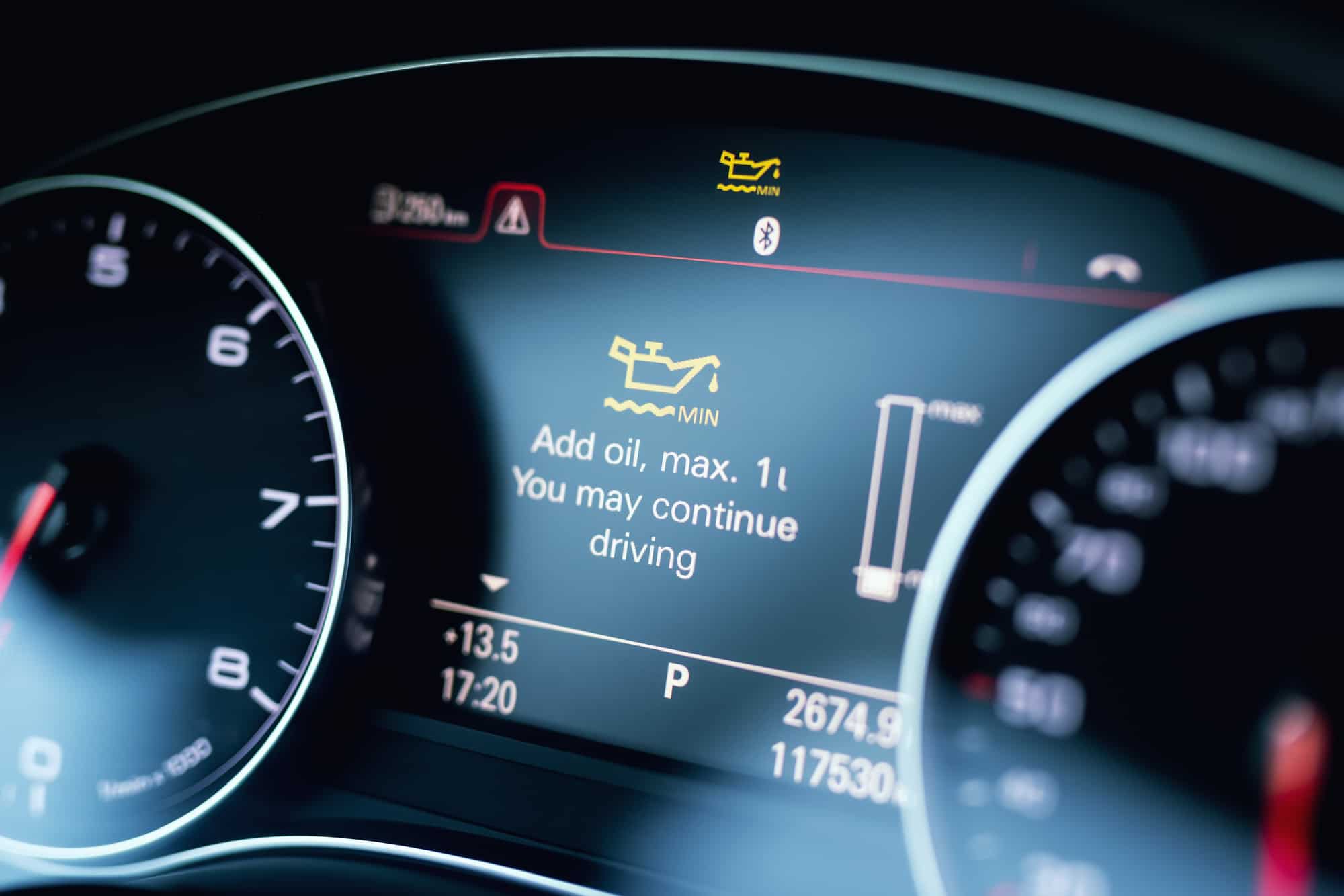When an engine is running, engine oil is pumped around the engine to keep it lubricated and to help prevent it from overheating. If the engine oil pressure drops too low, then the oil pressure warning light will light up on the dashboard. If this happens, how long can you continue to run the engine before damage occurs?
An engine with low oil pressure should not be run for any length of time. If the oil pressure warning light stays on then you should shut down the engine as soon as possible. Running an engine with low oil pressure is risky and can cause serious damage to the internal parts of the engine.
Low engine oil pressure can have many different causes such as low engine oil levels, a bad oil pump, leaking gaskets or seals, a blown head gasket, burnt valve seals, or a faulty engine oil pressure sensor.
As an Amazon Associate we earn from qualifying purchases.
Can an Engine Run with low oil pressure? (Is It Safe To Drive With the Oil Light On)?
An engine can in theory continue to run with low oil pressure indefinitely as long as internal damage to the engine does not occur.
However, damage to the engine is almost inevitable if there isn’t enough oil being pumped around the engine and this is what happens when the oil pressure drops too low. Generally, the damage will occur first at the top of the engine to the valve train and camshafts.
The engine will keep running if oil pressure hasn’t dropped too low but you will hear tapping or knocking noises coming from the valve guides due to a lack of oil.
When your car is running, engine oil is normally pumped around the engine by an oil pump that is located in the oil pan or beside the crankshaft. It is driven by the rotation of the engine and usually ensures that the oil pressure in the engine stays constant at around 50 to 60 psi.
Oil pressure within the engine is determined by a number of factors. These include the type and viscosity of engine oil, the strength, and speed of the oil pump, the permeability of the oil filter, and the mechanical resistance of the oil passages within the engine.
What Causes An Engine To Run With Low Oil Pressure? (5 Common reasons for low oil pressure)
If there is a loss of resistance within the engine due to a leak or a problem with the pumping of the oil around the engine, then this will lead to low oil pressure.
This problem can start to occur very quickly even if the engine is still running. It’s important to shut off the engine as soon as the oil pressure light comes on to avoid damage to the engine.
Here are a few of the causes of low oil pressure in more detail.
Cause 1: Low Engine Oil Levels
A lack of sufficient engine oil will cause low pressure and can damage the engine.
If there is not enough oil in the engine then the oil pump will not be able to build enough oil pressure to pump oil correctly to all parts of the engine.
Engine manufacturers determine the correct amount of oil needed in an engine to create the best conditions for lubrication and engine cooling. If the engine oil levels are too low then this can allow air into the mix and this can affect the ability of the oil to lubricate properly.
Cause 2: A bad oil pump
Another leading cause of low engine oil pressure is a bad or failing oil pump.
A bad oil pump will cause low oil pressure if it cannot generate enough power to pump the oil around the engine. Oil pumps are driven by the rotation of the camshaft or crankshaft, and should increase in speed and output as the engine speed increases.
Oil pumps can fail over time due to normal wear and tear. They can also fail because of infrequent oil changes that can lead to a build-up of sludge and dirt in the oil pan, engine oil contamination, using the wrong or inferior quality oil, or letting the engine oil run consistently low.
Cause 3: Blown head gasket
Damage to the cylinder head or a blown head gasket can cause a drop in oil pressure.
Engine oil is pumped around the engine block and cylinder head in oil channels and pipes. If there is a crack in the engine block or cylinder head then engine oil can start to leak into the engine cylinders.
If it’s only a small leak then once in the engine cylinders it can mix with the fuel mixture and burn off during combustion. Larger leaks will lead to engine failure pretty quickly.
Another common side effect of a blown head gasket is coolant leaking into the oil channels of the engine. This dilutes the oil and changes its viscosity and lubricating properties, causing a drop in oil pressure.
Cause 4: Wrong viscosity or bad oil
Using the wrong specification or weight of engine oil will also have an adverse effect on the engine oil pressure when the engine is running.
Engine oils come in numerous different weights or viscosities that are designed to work in specific engines. Modern synthetic engine oil is composed of a base oil with additives added that ensure the oil performs properly under a range of engine conditions.
The wrong engine oil may be too thick or too thin when cold or when the engine is hot, and this will affect how easily it can be pumped around the engine. Many engine oils also cling to the engine components when the engine is turned off to enhance lubrication and minimize wear and tear when the oil pump is not pumping.
All of these properties of modern engine oil will affect the oil pressure and the performance of the oil pump and can cause low oil pressure if the wrong oil is used.
Can Low Oil Pressure Lead to a P06DD Code in My Engine?
If you are experiencing a P06DD code in your engine, diagnosing engine oil pressure issues is crucial. Low oil pressure can cause this code to show up, indicating a potential problem with the oil system. It’s important to address any oil pressure issues promptly to avoid damage to the engine.
Cause 5: A Blocked oil filter
A blocked or dirty oil filter is also a very common cause of low oil pressure if it is restricting the passage of oil around the engine.
Most oil filter housings have a pressure relief valve fitted to allow oil to bypass the oil filter if it becomes too impermeable to allow oil through. This however can cause a drop in oil pressure if there is no longer a resistance generated by the oil filter.
In some cases, a blocked oil filter will simply restrict the flow of oil and this can cause low oil pressure if there is a lack of oil in certain parts of the engine because of this backup.
Using a cheap quality filter can also have the same effect as a blocked filter. Cheap filters are often less permeable and the material used is not as rigid as more expensive OEM filters.
Some car manufacturers such as BMW use paper filters that fit into an oil filter housing. A cheap or non-OEM filter can sometimes collapse when exposed to high pressures within the oil filter housing. This can have catastrophic effects on the engine if it means part of the engine becomes starved of oil when driving.
How Does Low Oil Pressure Impact Engine Oil Temperature?
Low oil pressure can disrupt the circulation of oil, leading to increased friction and heat in the engine. This can result in the engine oil temperature exceeding the ideal engine oil temperature norms, causing potential damage to the engine components. It’s essential to maintain proper oil pressure to ensure optimal temperature regulation.
What Next – How Long Can You Drive With The Oil Pressure Light On?
If the oil pressure light comes on in your car when you are driving, then it’s advisable to pull over as soon as possible and investigate the problem.
Here are a few initial steps to take when checking out an oil pressure warning.
- Check the oil level. The first thing to do after you pull over is to turn off the engine and leave the car to sit for around 10 minutes. This will allow the engine oil to settle in the engine and you can get an accurate reading when you dip the oil. If your car has a standard dipstick, carefully remove it and wipe it clean with a cloth. Push it fully back into the engine and remove it again to get a reading of the oil level in the engine. If it looks ok then there may be a problem with the oil pump, and oil pressure sensor or there may be an oil blockage in the engine.
- Check for oil leaks. Carefully look over the engine for obvious oil leaks. Fresh oil will be warm and will appear wet and light brown in color. Take care not to burn yourself on the hot engine, and feel for leaking oil anywhere there are dark or dried areas that look dirty. Check under the car for oil dripping onto the engine guard or onto the pavement. If you find a small oil leak then you can try topping up the oil so that you can continue to drive until the leak can be repaired properly.
- Check the coolant level and engine oil condition. Sometimes an internal engine leak such as a blown head gasket can cause a drop in oil pressure if coolant leaks into the engine oil channels in the engine. Check the coolant level in the coolant reservoir and ensure there are no obvious coolant leaks around the engine bay. Remove the engine oil refill cap and check for white or brown sludge underneath the cap or in the top of the engine. Brown milky residue can indicate coolant mixing with engine oil.
- Run an OBD-II diagnostic. If there is no obvious loss of engine oil then there may be a problem with the fuel pump or fuel pressure sensor. Have a look for engine error codes that point to a problem with the engine oil system. Error code P06DD can indicate a problem with the oil pressure in the engine. This accompanied by error P0524 can point to a problem with the oil pump. Error code P0520 can indicate a problem with the oil pressure sensor circuitry and this code may also trigger a check engine light.
FAQ – How Long Can An Engine Run With Low Oil Pressure?
1. How Little Oil Can An Engine Run On?
Generally, the least amount of engine oil you should have in your engine corresponds to the u003cstrongu003eminimum mark on the dipsticku003c/strongu003e. This is the least amount of engine oil that is safe to use without damaging the engine as determined by the vehicle manufacturer. u003cbru003eYou should always check the oil level when the engine is warmed up and has been sitting with the engine turned off for around 10 to 15 minutes. This will give the most accurate indication of the amount of oil in the engine.
2. Can a car turn off because of low oil?
Low engine oil can cause a car to shut off if it becomes mechanically difficult to run or overheats. Engine oil is used to lubricate and cool the engine. If there is not enough oil then this can cause an engine to seize in extreme circumstances due to a lack of lubrication. If the car is being driven hard in extreme weather then low oil may also contribute to over heating and this can cause an engine to cut out.
As an Amazon Associate we earn from qualifying purchases.





Is there a way to accurately diagnose which of these causes is responsible for the low oil pressure without visiting a mechanic?
Is it possible for an engine to stop running while I’m driving if the oil level gets too low, or would it give some warning first?